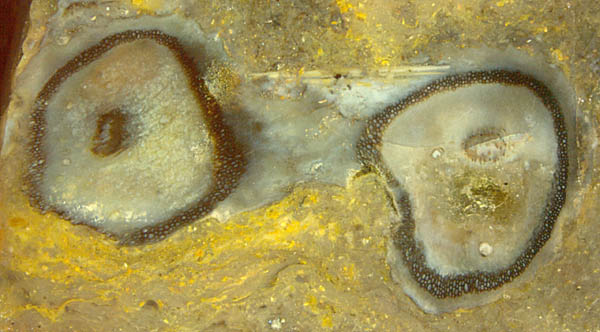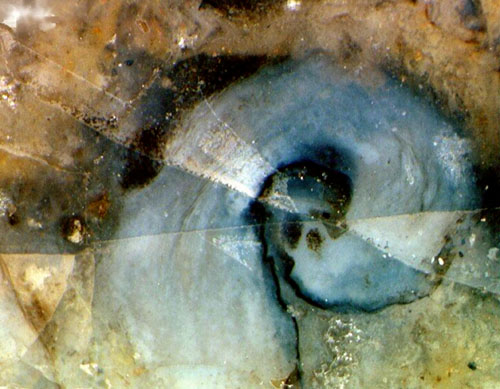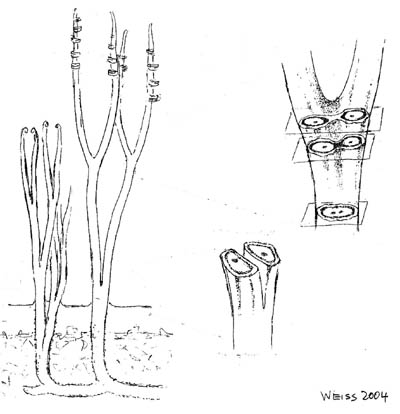Ventarura
taking shape
The latest discovery of a „higher“ plant in the Lower Devonian Rhynie
chert dates back no further than to the mid-nineties. As described in
[1] it had been found in fragments of one large pod dug up near the
Windyfield farms and thus named Ventarura,
which is the Latin
equivalent of windy field. (*)
 Its prominent feature is a conspicuous dark ring seen on cross-sections
of the upright axes. It consists of cells obviously more
resistant against decay than other parts of the tissue are.
Various proposals concerning its possible function have been considered
in [1]. ****
Its prominent feature is a conspicuous dark ring seen on cross-sections
of the upright axes. It consists of cells obviously more
resistant against decay than other parts of the tissue are.
Various proposals concerning its possible function have been considered
in [1]. ****
Fig.1:
Ventarura cross-section
of upright axis with typical ring consisting of persistent cell walls. Width of the
section 5mm;
Additional
structural information came unexpectedly from a small piece of chert
(0.2kg) found in 1998, whose true nature was recognized only after the
paper [1] became available (**). In addition to Ventarura
cross-sections as the one in Fig.1 it shows pairs of such. One type of sections (Fig. 2) seems to
represent the 30° forking reported in [1], which may occur near the
fertile region. Another type, also pictured in Fig.4, may occur below or on sterile shoots. The
branching seems to be fairly symmetrical here but there is other
evidence [2] that this is not always so.

Fig.2: Cross-section of forking axis of Ventarura. The
dark
tube inside has become two separate tubes but the faintly seen outline indicates
that there is a connection between them (see Fig.4). Note also the
horizontal agate bands
revealing that the plant was not upright but lying low during
silicification. Width of the picture 13mm.

Another thin slab cut from the small specimen in 2004
reveals a
tiny incurved tip, probably the top of a not fully grown-up shoot (Fig.
3). This sparse additional fossil material discovered lately has led to
a tentative reconstruction (Fig.4).
Fig.3 (left):
Section of incurved tip, dark spots possibly representing nascent
sporangia. Width of the picture 4.6mm. Photograph:
Hagen
Sahm

Fig.4 (right):
Tentative reconstruction of Ventarura
based on [1] and
own finds. (***)
Specimens found lately as well as those described in [1]
indicate more profuse and
unequal branching below. Also there is evidence for new shoots developing inside older ones, similar as observed with Trichopherophyton.
Annotations
*
The chert where Ventarura
was discovered differs in location and
stratigraphy from the previously known stack of Rhynie chert layers and
therefore has been named Windyfield chert [3].
** This chert sample
was found well away from the Windyfield site so that it is either
displaced Windyfield chert or else can serve as first evidence for the
presence of Ventarura
in other Rhynie chert layers. Presented
at the
3rd Chert Meeting,
Chemnitz, 2004.
*** According to [1] and a few new finds, the rhizome is more profusely branched.
**** Evidence contradicting the idea of a reinforcing tube inside Ventarura has been accumulated since. See Rhynie
Chert News 60, 66, 82 .
Sample: 0.2kg, found by Sieglinde Weiss in 1998. The rolled-up tip in Fig.3 has remained the only one ever found up to now (2016).
H.-J.
Weiss
2005, emended up to 2016
[1]
C.L. Powell, D.
Edwards, N.H. Trewin:
A new vascular plant from the
Lower Devonian Windyfield chert, Rhynie, NE Scotland.
Trans. Roy. Soc. Edinburgh, Earth Sci.
90(2000 for 1999), 331-349.
[2] www.abdn.ac.uk/rhynie
[3]
N.H. Trewin, C.M. Rice: Stratigraphy and Sedimentology of
the Devonian Rhynie chert locality.
Scottish J. Geol.
28(1992) , 37-47.
 |
 |
3 |


 Its prominent feature is a conspicuous dark ring seen on cross-sections
of the upright axes. It consists of cells obviously more
resistant against decay than other parts of the tissue are.
Various proposals concerning its possible function have been considered
in [1]. ****
Its prominent feature is a conspicuous dark ring seen on cross-sections
of the upright axes. It consists of cells obviously more
resistant against decay than other parts of the tissue are.
Various proposals concerning its possible function have been considered
in [1]. ****



